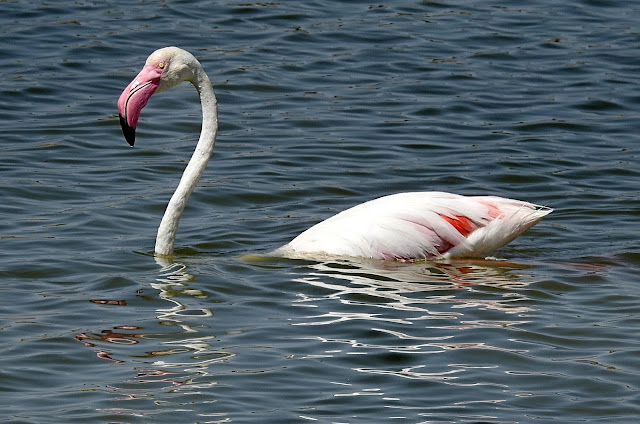The Greater flamingo (Phoenicopterus roseus) is the most widespread and largest species of the flamingo family. It was described by Peter Simon Pallas in 1811. The Greater flamingo was previously thought to be the same species as the American flamingo, but because of coloring differences of its head, neck, body, and bill, the two flamingos are now most commonly considered separate species.
Greater flamingos have an attractive coloration and appearance. Their feathers are pinkish/white, the wing coverts are red and the primary and secondary flight feathers are black. They have long pink bills with a black tip, yellow eyes and long pink legs. The male is bigger than the female, and juveniles have a gray-brown coloration, with some pink on their underparts, tail and wings, with the legs and beak being mainly brown.
The Greater flamingo inhabits Africa, the Middle East, southern Europe, and the Indian subcontinent. They occur in relatively shallow water bodies, such as saline lagoons, salt pans, large alkaline or saline lakes, and estuaries. Breeding takes place on sandbanks, mudflats, sandy or rocky islands, or open beaches.
Greater flamingos are very social. They travel in groups numbering up to thousands and they communicate by using visual and auditory cues. Greater flamingos are partially dispersive and migratory. They are traveling constantly, seeking areas with enough resources to sustain the whole flock, especially during the mating season. Greater flamingos keep their chicks together in crèches. Adults supervising crèches tend to act in a hostile way toward hatchlings if their own young are not in that crèche. Greater flamingos are diurnal, feeding during the day. Being bottom feeders, they rely on water levels that are low, and they move to new areas to find appropriate feeding conditions. They often bathe in fresh shallow water and preen their feathers to remove salt from them. They are not territorial birds but during breeding season they do defend their nests.
The Greater flamingo (Phoenicopterus roseus) is the most widespread and largest species of the flamingo family. It was described by Peter Simon Pallas in 1811. The Greater flamingo was previously thought to be the same species as the American flamingo, but because of coloring differences of its head, neck, body, and bill, the two flamingos are now most commonly considered separate species.
The greater flamingo, Phoenicopterus roseus, stands as the most widespread and largest member of the flamingo family. This majestic bird is adorned with pinkish-white plumage, save for the red wing coverts and contrasting black primary and secondary flight feathers. The bill is a striking pink with a black tip, and the legs are a uniform pink, completing the iconic look of this species.
Adult greater flamingos can be identified by their height, ranging from 110 to 150 cm, and their weight between 2 and 4 kg. The largest males can reach up to 187 cm tall and weigh 4.5 kg. Observers should note the distinctive coloration, with the majority of the body being pinkish-white, red wing coverts, and black flight feathers. The pink bill with a black tip and entirely pink legs are also key identification features. The call of the greater flamingo is reminiscent of a goose-like honking.
Greater flamingos favor mudflats and shallow coastal lagoons with saline water, where they can be seen stirring the mud with their feet in search of food.
This species is common in the Old World, with a range that includes Northern and Sub-Saharan Africa, the Indian Subcontinent, the Middle East, the Levant, and Southern Europe. Notably, they are found in coastal regions and along water bodies such as the Nile River, the Persian Gulf, the Gulf of Aden, the Red Sea, and the Mediterranean.
Greater flamingos are social birds, often found in large flocks. They feed with their heads down, filtering out sustenance from the water with their specially adapted bills. During the breeding season, these birds engage in a fascinating display of spreading uropygial secretions over their feathers to enhance their color, a behavior likened to applying "make-up."
The vocalization of the greater flamingo is a distinctive honking, similar to that of a goose, which can be heard over considerable distances.
The species lays a single chalky-white egg on a mud mound, a typical breeding behavior for flamingos.
While similar to the American flamingo, the greater flamingo can be distinguished by differences in head, neck, body, and bill coloration.
Greater flamingos feed on a diet that includes small shrimp, seeds, blue-green algae, microscopic organisms, and mollusks. They filter their food from the water with their downward-facing heads and movable upper jaws.
The IUCN Red List classifies the greater flamingo as Least Concern, indicating a stable population. However, they face threats from habitat encroachment and pollution in their water supplies.







